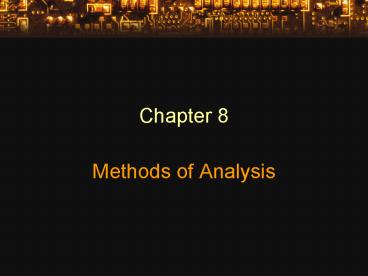Methods of Analysis PowerPoint PPT Presentation
1 / 19
Title: Methods of Analysis
1
Chapter 8
- Methods of Analysis
2
Constant Current Sources
- Maintains the same current in the branch of the
circuit regardless of how components are
connected external to the source. - The direction of the current source arrow
indicates the direction of current flow in the
branch. - The voltage across the current source depends on
how the other components are connected.
3
Constant Current Sources
- In a series circuit, the current must be the same
everywhere in the circuit. - If there is a current source in a series circuit,
that will be the value of the current for that
circuit. - For the circuit shown,
- I 2 mA
4
Source Conversions
- In circuit analysis it is sometimes convenient to
convert between voltage sources and current
sources. - To convert from a voltage source to a current
source, calculate the current from E/RS. - RS does not change.
- Place the current source and the resistor in
parallel.
5
Source Conversions
- We can also convert from a current source to a
voltage source. - E IRS
- Place the voltage source in series with the
resistor.
6
Source Conversions
- A load connected to a voltage source or its
equivalent current source should have the same
voltage across it and current through it for
either source. - Although the sources are equivalent, currents and
voltages within the sources may differ. - The sources are only equivalent external to the
terminals.
7
Current Sources in Parallel and Series
- Current sources in parallel simply add together.
- The magnitude and direction of the resultant
source is determined by adding the currents in
one direction then subtracting currents in the
opposite direction. - Current sources should never be placed in series.
This would violate KCL.
8
Branch Current Analysis
- For circuits which have more than one source, we
have to use different methods of analysis. - Begin by arbitrarily assigning current directions
in each branch. - Label the polarities of the voltage drops across
all resistors. - Write KVL around all loops.
- Apply KCL at enough nodes so all branches have
been included. - Solve the resulting equations.
9
Branch Current Analysis
- From KVL 6 - 2I1 2I2 - 4 0
- 4 - 2I2 - 4I3 2 0
- From KCL I3 I1 I2
- Solve the simultaneous equations.
10
Mesh Analysis
- Arbitrarily assign a clockwise current to each
interior closed loop. - Indicate the voltage polarities across all
resistors. - Write the KVL equations.
- Solve the resulting simultaneous equations.
- Branch currents are determined by algebraically
combining the loop currents which are common to
the branch.
11
Mesh Analysis
- Assign loop currents and voltage polarities.
- Using KVL 6 - 2I1 - 2I1 2I2 - 4 0
- 4 - 2I2 2I1 - 4I2 2 0
- Simplify and solve the equations.
12
Format Approach
- Mutual resistors represent resistors which are
shared between two loops. - R12 represents the resistor in loop 1 that is
shared by loop 1 and loop 2. - The coefficients along the principal diagonal
will be positive. - All other coefficients will be negative.
- The terms will be symmetrical about the principal
diagonal.
13
Format Approach
- Convert current sources into equivalent voltage
sources. - Assign clockwise currents to each independent
closed loop. - Write the simultaneous linear equations in the
format outline. - Solve the resulting simultaneous equations.
14
Nodal Analysis
- Assign a reference node within the circuit and
indicate this node as ground. - Convert all voltage sources to current sources.
- Assign voltages V1, V2, etc. to the remaining
nodes. - Arbitrarily assign a current direction to each
branch where there is no current source.
15
Nodal Analysis
- Apply KCL to all nodes except the reference node.
- Rewrite each of the currents in terms of voltage.
- Solve the resulting equations for the voltages.
16
Format Approach
- Mutual conductance is the conductance that is
common to two nodes. - The mutual conductance G23 is the conductance at
Node 2, common to Node 3. - The conductances at particular nodes are
positive. - Mutual conductances are negative.
- If the equations are written correctly, the terms
will be symmetrical about the principal diagonal.
17
Format Approach
- Convert voltage sources into equivalent current
sources. - Label the reference node as ground.
- Label the remaining nodes as V1, V2, etc.
- Write the linear equation for each node.
- Solve the resulting equations for the voltages.
18
Delta-Wye Conversion
- Any resistor connected to a point of the Y is
obtained by finding the product of the resistors
connected to the same point in the Delta and then
dividing by the sum of all the Delta resistors. - Given a Delta circuit with resistors of 30, 60,
and 90 ?, the resulting Y circuit will have
resistors of 10, 15, and 30 ?.
19
Wye-Delta Conversions
- A Delta resistor is found by taking the sum of
all two-product combinations of Y resistor values
and then dividing by the resistance of the Y
which is located directly opposite the resistor
being calculated. - For a Y circuit having resistances of 2.4, 3.6,
and 4.8 ?, the resulting Delta resistors will be
7.8, 10.4, and 15.6 ??. ?

